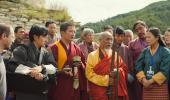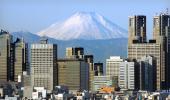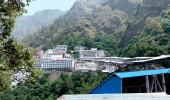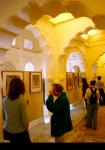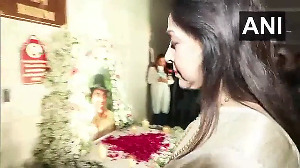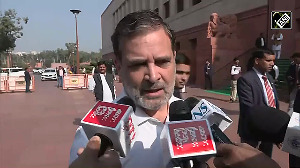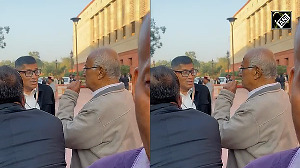The visitor returns not just with the jewel-like beauty of the country imprinted on the mind, the body rejuvenated by hot stone massages, but also with the captivating stories and myths that are built into every important structure -- whether a tourist magnet or an off-the-beaten track spot.

A young Bhutanese man gazes wistfully out of the window as the plane descends to Paro airport.
He is returning home after four years in Thailand.
"You feel refreshed in Bhutan," he says. And he is right!

The tiny Himalayan kingdom is like a glittering gem -- the air is clean and fresh, the rivers and forests sparkle with an unpolluted gleam. And most of all it's the silence.
Nobody shouts, no cars honk. Even the usually raucous Indian tourists -- and there are plenty -- lower their voices.
Indians do not need a visa to visit Bhutan, only a permit is required.
The country's currency is Ngultrum, but Indian rupees are accepted everywhere.
The main street in Paro has a row of shops, and it is surprising to see a marketplace so quiet -- nobody pushes souvenirs on to tourists or haggles loudly.

Maybe because of its small size or low population, Bhutan has managed the impossible -- it has modernised, but has also preserved the old ways of life.
It takes a while for the visitor to register that all structures follow the same architectural design -- the sloping roofs, carved windows and balconies painted with traditional motifs -- making one feel like one has entered a pop-up picture book.
It is also mandatory for all in the government, hospitality and tourism sectors (which is almost everybody) to wear the national dress -- the men wear a knee-length tunic called gho, legs covered with high socks, the women a lungi-like garment called kira, paired with a long-sleeved jacket called wonju.
The kabney is a long shawl draped over the left shoulder.
The colour of the kabney indicates the wearer's social status.
White is worn by common citizens, orange by government officials, and saffron by the King.
The kabney is a must during formal occasions and when entering government buildings or religious sites.
If all this seems a bit strict to outsiders, the locals are deeply respectful of their king -- currently Jigme Khesar Namgyel Wangchuk, whose rule began in 2006, when his father, Jigme Singye Wangchuk abdicated the throne.
They obey the rules set by the king, and appreciate the fact that he and his family live a simple life and care for their subjects.

Bhutan is a democratic constitutional monarchy, with the king as head of State, a Prime Minister heading the government and a Je Khenpo is the head of the State religion, which is Buddhism.
Religion and politics go together, says the local guide, the knowledgeable and patient (with endless questions) guide, Rinchen Dorje, picked by WeGoBond to conduct the all-women tour of Bhutan, with the energetic Aditi Prasad.
The local language is Dzongkha, but most Bhutanese speak English and a few speak Hindi, which they claim they learnt from watching Bollywood movies.
Mercifully, the Bollywood industry has not attempted to use Bhutan too often as a shooting location.
Bhutan has a small film industry of its own; the 1999 film, The Cup by Khyentse Norbu, was the country's first submission for the Oscars and was a charming story of two young monks who want to watch the 1998 FIFA World Cup final, and how they manage to accomplish that.
In 2021, the film Lunana: A Yak in the Classroom by Pawo Choyning Dorji, was nominated in the Best International Feature Film category.
Padmasambhava or Guru Rimpochey is credited with bringing Buddhism from India to Tibet and then to Bhutan.
Legend says that Padmasambhava flew on a tigress from Tibet to Bhutan to Taktsang or the Tiger's Nest Monastery in the 9th century, meditated for three years, three months, three weeks and three days before establishing the Nyingma Vajrayana Buddhism sect in the kingdom.
Buddhism is now deeply embedded into the lives of the people, with their own beliefs and myths added to the rich and magical lore passed down the ages.
The many monasteries are tourist attractions -- including the famous Tiger's Nest, a 5 to 9-hour trek (depending on the hiker's energy and experience) that requires stamina and lung power that most ordinary mortals do not possess, but those who do, are rewarded with breathtaking vistas and a kind of spiritual upliftment.

Even the Cheri monastery that is at a lower altitude, is a tough climb over steep steps and unpaved paths.
It was a practice for families to send a son to monasteries to study to become lamas.
Not as prominent, but a significant part of Bhutanese society are the nunneries for women.
It is believed that this practice may have helped control the population of the country.

From Paro, where the airport is located, a drive to the capital, Thimphu, requires a stop to admire the historic Tachogang Lhakhang bridge, an iron chain suspension bridge connecting the Tachog Lhakhang temple on one side and the other side of the Pa Chhu river.
The original, built in the 15 century by Thangtong Gyalpo, a Tibetan saint and engineer, was restored in 2005.
On the way, there are well stocked shops selling vegetables, spices, cheese and condiments, mostly managed by women.

Then, the beautiful sight of the confluence of the Paro and Thimphu rivers.

Thimphu has the only traffic policeman in the country, who serves an ornamental purpose, directing perfectly disciplined traffic, from his cute little island.
The city needs no traffic lights, as people drive carefully and politely stop to let pedestrians cross if they see any standing by the side of the road.
There is no place for overtaking or road rage here.
Bhutan is known to be the world's happiest place, but what it is really is a believer in Gross National Happiness (instead of Gross Domestic Product), under which the well being of citizens and protection of the environment and the traditional way of life is given priority.
Because it is so green and unpolluted, Bhutan is the only carbon-negative country in the world (more carbon dioxide is cleared than emitted).
Healthcare and education are free, and the country takes care to preserve its culture, festivals and rituals.
A typical feature of the landscape are the colourful flags fluttering in the breeze, and the white flags planted on poles by the riverside to honour ancestors.
There are shops selling Indian, Chinese, Japanese and Korean goods -- Bhutan grows its own food, but everything else is imported.
They eat meat brought in from outside, their Buddhist beliefs preventing them from slaughtering animals.
The food is simple, and wholesome with red rice, noodles, soups, vegetables, cheeses, fish and chicken as staples.
There is no concept of dessert in the cuisine, which probably accounts for their good health.
Tea with yak butter, sprinkled with roasted rice, is offered to guests, which is not to everybody's taste.
The spice-corrupted Indian palate is placated with the aid of red chillies in oil and the famous Ema Datshi, a dish of green chillies in cheese.

Some of the local cuisine is sampled at the Babesa Village Restaurant, a family-run eatery, established in the owner's 500-year-old ancestral home, that has preserved its ancient kitchen and wooden utensils.

The food is freshly cooked with farm-sourced ingredients, and as delicious as it is healthy, the meal is accompanied by the local rice wine.


Photograph: Kind courtesy Akshay Nayak/Pexels.com
Before the people adopted Buddhism, the religion of the country also known as the Dragon Kingdom, was Bon, a nature-worshipping faith.

That perhaps explains the presence of colourfully-painted phalluses that are sold in souvenir shops, and also painted on homes and walls and nobody seems embarrassed about it.
They are also offered at the Chimi Lhakhang Temple of Fertility, where couples come to pray for children and bring newborns to be named there.
The practice of accepting the phallus as a symbol of good luck, and fertility, is, however, attributed to the Buddhist saint Drupka Kunley, who wanted to simplify spiritual concepts.

Photography is not allowed inside the Buddhist temples and monasteries, but they are beautifully decorated with statues, iconography, murals depicting the various forms and postures of Buddha and fragrant with flowers and incense.
Outside Thimphu, the huge Dordemna Buddha statue on a hill is visible for miles around, but what is awe-inspiring are the 125,000 small statues displayed inside.



At the Gangtey monastery, there are rare relics and treasures that are brought out on special occasions.
Stories and legends about the various incarnations of Buddha and his devotees are part of Bhutanese folklore.
It is believed that after 1002 incarnations of Buddha, the world will come to an end.

The Black Necked Crane is a winter visitor to Bhutan, where the graceful birds are said to circle the Gangteng monastery three times and then make their way to the Phobjikha Valley, and repeat that when they leave after their nesting season.
Bhutan takes great care to protect the birds the people consider lucky, and have protected sanctuaries for them.

The Punakha Dzong is a fascinating complex of courtyards, temples and rooms that once housed the administration of Bhutan, before the capital was shifted to Thimphu.
There are thrones inside the complex, and the coronation of the present king was held there, as was his wedding to Jetsun Pema.

The coronations of the older kings of the Wangchuck dynasty established in 1907, were also conducted at this magnificent site.

The Dzong is located between the Pho Chhu (Male) and Mo Chhu (Female) river in the Punakha-valley.
After the confluence of these two rivers, the main river is known as Puna Tsang Chu which at some point crosses the Bhutan-India border at Kalikhola and eventually meets the Brahmaputra river.

The traveller is often stopped short by the sheer beauty of the countryside, still the view from Dochula Pass -- on clear days, Himalayan peaks are visible -- is breathtaking.

This mountain pass is on the on the road from Thimphu to Paro, and marked by the 108 memorial stupas built by the eldest Queen Mother Ashi Dorji Wangmo Wangchuk, as a memorial to honour Bhutanese soldiers who were killed in the December 2003 battle against Assamese insurgents from India, which then king Jigme Singye Wangchuck won.
Bhutan is a peaceful country, but there was strife in the past, between fiefdoms and wars with Tibet.
The bearded figure of the Unifier is found in the temples.
He was Ngawang Namgyal (1594-1651), who united several warring tribes and united Bhutan as a nation State in the 1630s.
He also enabled the creation of a Bhutanese culture, distinct from Tibet that had influenced it.
The first European visitors to Bhutan were Estêvão Cacella and João Cabral, two Portuguese Jesuit missionaries who arrived in Bhutan in 1627, on their way to Tibet.
They sought to convert the Bhutanese people to Christianity, and failed.
Interestingly, its inaccessibility meant that Bhutan was never colonised by the British, which helped preserve its way of life.
It did, however, become a protectorate of the British Empire, by signing the Treaty of Punakha that granted some rights to the British in exchange for autonomy in Bhutan.
According to information on the Internet, the arrangement continued under a new treaty with India in 1949, signed at Darjeeling, in which both countries recognised each other's sovereignty.
The impact of India is visible in the presence of several well-known brands in the shops.
Indian food is easily available and the tea bags in hotel rooms come from a Kolkata company.
There is a cricket academy sign in Thimphu, though football is a passion with Bhutanese and archery the national sport.

The visitor returns not just with the jewel-like beauty of the country imprinted on the mind, the body rejuvenated by hot stone massages, but also with the captivating stories and myths that are built into every important structure -- whether a tourist magnet or an off-the-beaten track spot.

That tourism has made inroads into Bhutan is seen in the karaoke signs outside small shacks; homestays have sprouted over the pristine countryside, and after a trek through fragrant pine forests, there is a hot home-cooked meal available to be savoured at a family-run farmhouse.
In Bhutan, the lush pine forests provide the wood for the homes and furniture.
In the near future, will Bhutan catch up with the rest of the world, or teach the world its spiritual and sustainable way of life?
There is talk of a new city being built -- the Gelephu Mindfulness City -- in southern Bhutan near the border with India -- a large planned city the size of Singapore.

The new airport promises to be dazzling and the design of the city is unique, with neighbourhoods like mandalas, with repeated patterns that originate from a central public space.
Photographs of the architectural plans revealed so far look like something out of a futuristic sci-fi movie, but also typically, traditionally Bhutanese.
Bhutan is often called the Last Shangri-La -- in his 1933 novel The Lost Horizon, James Hilton had referred to a fictional place, a hidden Himalayan paradise, an idyllic utopia.
In a chaotic world hurtling towards environmental disaster, Bhutan comes close to that fantasy.
Feature Presentation: Ashish Narsale/Rediff


